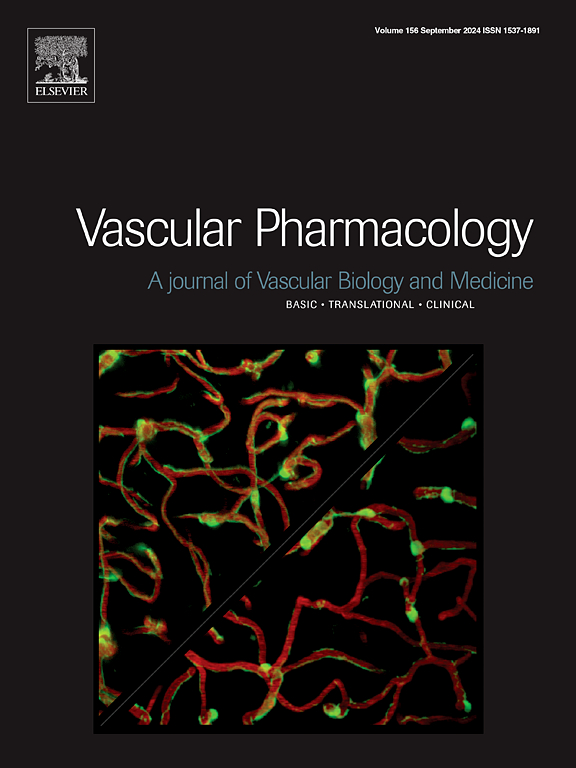来自人类动脉粥样硬化组织单细胞转录组学的内皮到间充质转化基因标记与稳定斑块组织学特征相关
IF 3.5
3区 医学
Q2 PHARMACOLOGY & PHARMACY
引用次数: 0
摘要
背景:动脉粥样硬化斑块内的内皮细胞可以通过内皮-间充质转化(EndoMT)分化为间充质样表型。我们对EndoMT在人类动脉粥样硬化中的分子机制的理解仍然有限。目前的基因表达特征通常来自体外实验或动物研究,通常反映了完全分化间充质细胞状态下基因的上调,而在此过程中上调的基因则被省略。为了解决这一知识差距,我们利用来自人类斑块组织的单细胞转录组(scRNA-seq)数据的计算机谱系追踪来鉴定EndoMT基因表达特征。方法和结果我们在人颈动脉scRNA-seq数据中构建了三个候选EndoMT谱系,涉及ECs和SMCs亚群(n = 46)。我们检查了这些谱系中的基因表达,并确定了在EndoMT中上调的73个基因的核心特征。这些基因的上调在来自斑块组织的其他人类数据集的EndoMT轨迹和Cdh5-CreERT2 Rosa-eYFP apoE−/−谱系追踪小鼠中得到证实。对人颈动脉斑块体积RNA-seq数据(632例患者)的分析发现,核心基因标记与纤维性和更稳定的组织学表型相关。结论本研究明确了人动脉粥样硬化斑块中EndoMT的核心基因特征,可为今后的研究和基因集富集分析提供参考。本文章由计算机程序翻译,如有差异,请以英文原文为准。

Endothelial-to-mesenchymal transition gene signature derived from single-cell transcriptomics of human atherosclerotic tissue associates with stable plaque histological characteristics
Background
Endothelial cells within atherosclerotic plaques can differentiate into a mesenchymal-like phenotype through endothelial-to-mesenchymal transition (EndoMT). Our understanding of the molecular mechanisms underlying EndoMT in human atherosclerosis remains limited. Current gene expression signatures are often derived from in vitro experiments or animal studies and typically reflect genes upregulated in fully differentiated mesenchymal cell states, while genes upregulated during the process are omitted. To address this knowledge gap, we utilized in silico lineage tracing in single-cell transcriptomic (scRNA-seq) data from human plaque tissues to identify the EndoMT gene expression signature.
Methods and results
We constructed three candidate EndoMT lineages across subpopulations of ECs and SMCs in human carotid scRNA-seq data (n = 46). We examined gene expression over the course of these lineages and identified a core signature of 73 genes upregulated in EndoMT. Upregulation of those genes was confirmed in EndoMT trajectories of other human datasets derived from plaque tissue and in Cdh5-CreERT2 Rosa-eYFP apoE−/− lineage-traced mice. Analysis of human carotid plaque bulk RNA-seq data (632 patients) found the association of core gene signature with fibrous and more stable histological phenotypes.
Conclusion
This study defines the core gene signature of EndoMT in human atherosclerotic plaques, which can serve as a reference for future studies and gene set enrichment analysis.
求助全文
通过发布文献求助,成功后即可免费获取论文全文。
去求助
来源期刊

Vascular pharmacology
医学-药学
CiteScore
6.60
自引率
2.50%
发文量
153
审稿时长
31 days
期刊介绍:
Vascular Pharmacology publishes papers, which contains results of all aspects of biology and pharmacology of the vascular system.
Papers are encouraged in basic, translational and clinical aspects of Vascular Biology and Pharmacology, utilizing approaches ranging from molecular biology to integrative physiology. All papers are in English.
The Journal publishes review articles which include vascular aspects of thrombosis, inflammation, cell signalling, atherosclerosis, and lipid metabolism.
 求助内容:
求助内容: 应助结果提醒方式:
应助结果提醒方式:


